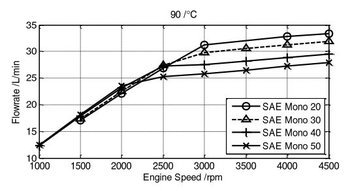No starved galleries, no. And yes, let pressures rise, that's not the point, that's only why it wouldn't even matter if somebody didn't know how to read "positive displacement pump" – we'd easily make it an extra fifty percent more positive for you and agree that so much positivity would always guarantee the same total flow. It would pump the more viscous oil under higher pressure. You're welcome, never questioned for the purpose of helping you. We'd even clear the regulator and pump reliefs away to minimize your losses.
Now this "total" would instruct you to have a look at ratios, biases, individual shares. With rising viscosity those may shift around, from smaller orifices to bearings' entrainments (or CAFE regulatory reliefs) or else. Therefore no fixed ratios, no constant shares. Would you prefer this paragraph underlined to the next paragraph set in bold?

Still no drama, from there we'd only continue following the lube making it via jets through crankcase air into the pistons (a fraction at least, hopefully) and subsequently through those pistons along new "paths of least resistance" for chilling effects. How much of your risen oil pressure do you think will stick to the higher viscosity travelling through the air and into the piston to reestablish more conventional flow for cooling effect all this was about? We agreed on ignoring reliefs and more, think of as much pressure there as possible. Hein?
This and certainly more the poor MC prof tended to pack into a sentence or two for the video you didn't want to know how to watch. Unwanted differences of a few Kelvin somewhere in pistons, deviations from what Ford had been designing for. That's not a video about causing catastrophic failures by topping up with a litre of 20W-70, never was. With me you're reading videos straw-free.



